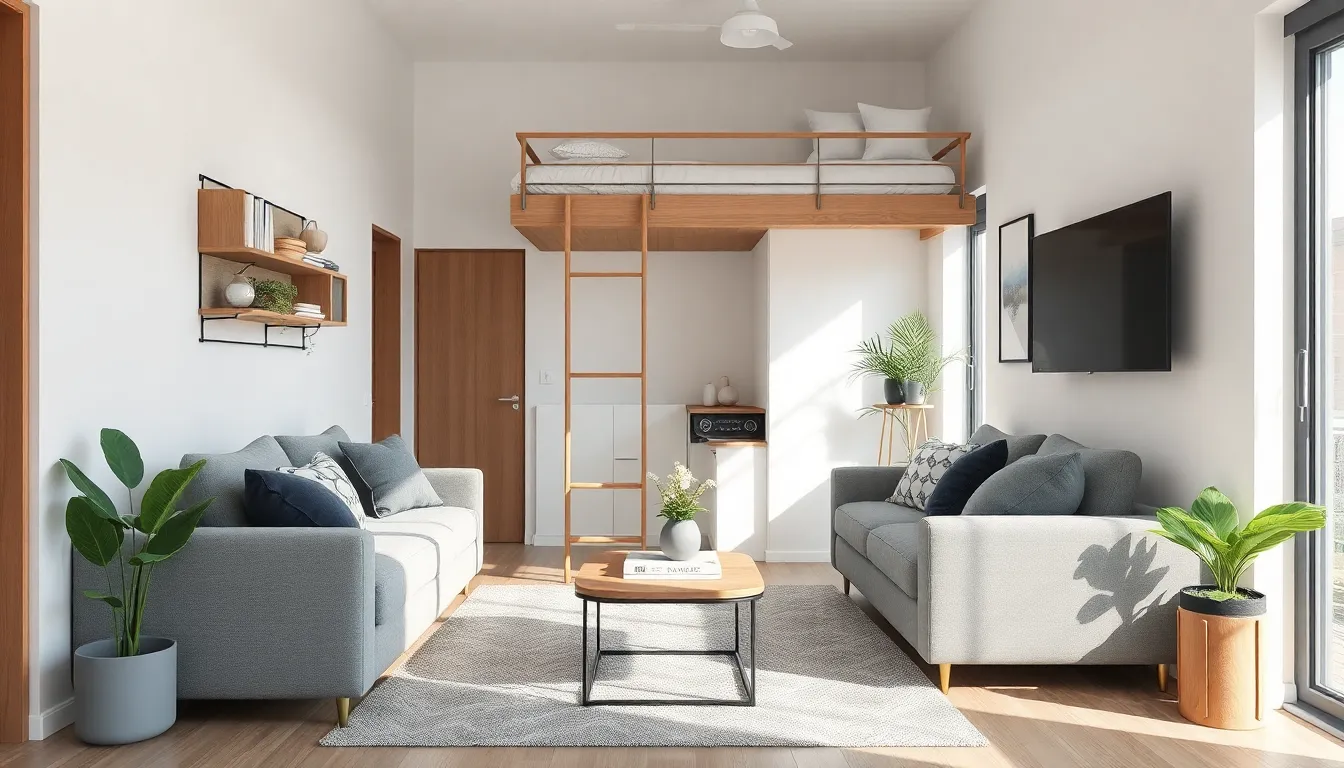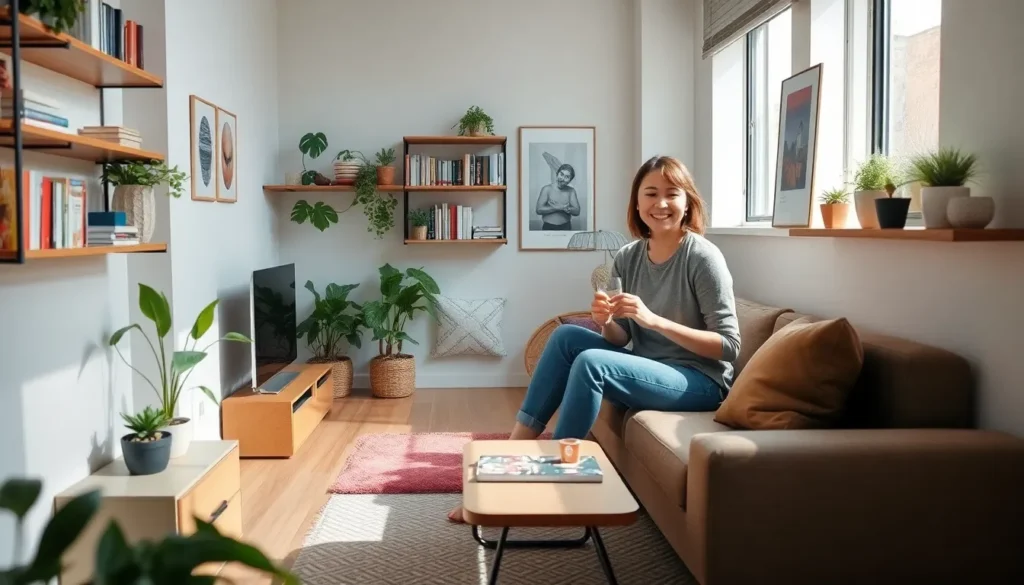Table of Contents
ToggleLiving in a small space doesn’t mean sacrificing style or comfort. In fact, it’s an opportunity to unleash creativity and embrace a minimalist lifestyle that many dream of. Picture this: a cozy nook that doubles as a reading corner and a guest bed. Who knew that a few clever hacks could turn a closet into a chic office?
As urban living becomes the norm, small space enthusiasts are proving that less truly is more. With the right strategies, even the tiniest apartments can feel like palatial retreats. So, if you’re ready to trade clutter for cleverness and transform your compact quarters into a stylish sanctuary, buckle up! It’s time to dive into the world of small space living, where every square foot counts and creativity reigns supreme.
Understanding Small Space Living
Small space living allows individuals to maximize functionality without sacrificing style. This lifestyle fosters creativity and minimalism, appealing to many urban dwellers.
Benefits of Small Space Living
Small spaces offer numerous benefits. First, they require less maintenance, which saves time and effort. Individuals often enjoy lower utility bills, providing financial relief. Creative storage solutions can increase efficiency and organization. Living in smaller areas typically encourages decluttering, leading to a more peaceful environment. Reduced environmental impact also arises from living in compact homes, reflecting a sustainable choice. This style promotes a sense of community as individuals often find themselves in closer proximity to neighbors.
Challenges of Small Space Living
Living in a small space presents challenges. Limited square footage can create feelings of confinement. Finding suitable storage solutions proves difficult without careful planning. Visitors may feel cramped in smaller environments, potentially impacting social life. Noise levels often increase, leading to distractions in work or relaxation areas. Designing multifunctional spaces requires ingenuity, which can be daunting. Without proper organization, clutter accumulates quickly, diminishing the aesthetic appeal of the space.
Designing Your Small Space

Creating an efficient layout in small spaces enhances both functionality and comfort. Clever design can transform constraints into opportunities.
Maximizing Vertical Space
Utilizing vertical space creates the illusion of a larger area. Install shelves to store books, plants, or decorative items. Hang hooks on walls for jackets or bags to free floor space. Consider tall furniture pieces that draw the eye upward. Use lofted beds to create under-bed storage or a workspace. Organizing items vertically allows for easier access while maintaining order.
Choosing Multi-Functional Furniture
Selecting multi-functional furniture optimizes small living areas. Look for sofas that convert into beds for guests. Coffee tables with hidden storage compartments offer a place for blankets or magazines. Desks that fold away can clear up floor space when not in use. Pieces like ottomans can function as both seating and storage units. Investing in adaptable furniture maximizes utility and contributes to a streamlined aesthetic.
Organizing for Efficiency
Efficient organization transforms small spaces into functional areas. Clever strategies maximize every inch, ensuring individuals can comfortably enjoy their homes.
Smart Storage Solutions
Utilizing vertical space is essential. Wall-mounted shelves can hold books, plants, or decorative items. Under-bed storage boxes keep seasonal clothes or shoes hidden but accessible. Multi-functional furniture, like ottomans that offer internal storage, provides added functionality without sacrificing style. Custom closet systems allow tailored storage options for clothing or equipment. Use pegboards in the kitchen or workspace to hang tools or accessories, creating easy access and freeing up counter space.
Decluttering Strategies
Regular decluttering maintains a serene environment. Implement a one-in-one-out policy to prevent overcrowding. Setting aside time each month to sort through belongings prevents accumulation. Prioritize items that serve clear purposes or bring joy. Use clear bins for visibility, making it easy to locate items. Create designated drop zones for mail or keys to reduce daily clutter. Emphasizing a minimalist approach fosters a peaceful atmosphere in small spaces.
Creating a Personal Oasis
Creating a personal oasis in a small space enhances comfort and style. Personal touches turn a generic apartment into a unique sanctuary.
Adding Personal Touches
Decorative elements personalize a space and showcase individuality. Incorporating artwork adds character, while family photos create warmth. Layered textiles, like throw blankets and cushions, inject comfort and style. Plants enliven environments, contributing to air quality and a calming atmosphere. Each item tells a story, making the space feel lived-in and loved.
Utilizing Color and Light
Color choices can dramatically influence the perception of space. Lighter shades, such as soft whites and pastels, make areas feel more open and airy. Accent colors add depth and personality without overwhelming. Natural light supports a vibrant ambiance; sheer curtains allow sunlight to filter through. Strategic lighting fixtures, like floor lamps and under-shelf lights, enhance functionality and mood during evening hours.
Embracing small space living offers a unique opportunity to cultivate a stylish and functional environment. By implementing clever design strategies and focusing on minimalism, individuals can transform their compact homes into personalized sanctuaries. This lifestyle not only promotes sustainability but also fosters a sense of community.
With the right approach to organization and design, small spaces can become efficient havens that enhance comfort and aesthetics. By prioritizing multifunctional furniture and maximizing vertical space, residents can enjoy the benefits of urban living without sacrificing style. Ultimately, small space living encourages creativity and adaptability, making it a rewarding choice for many.




